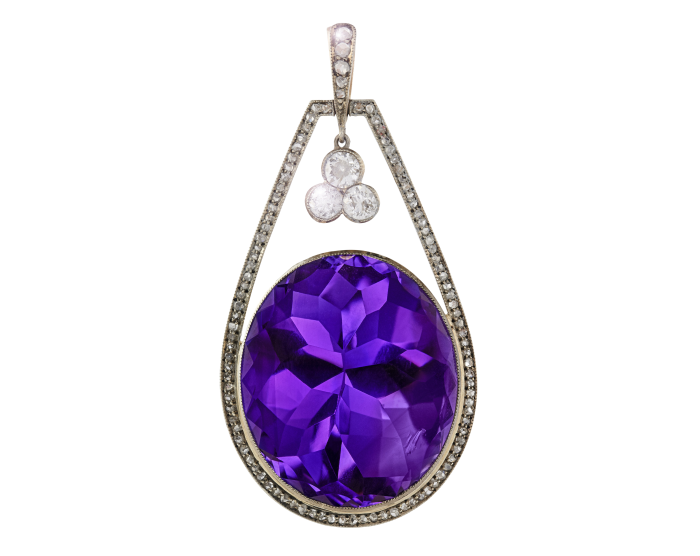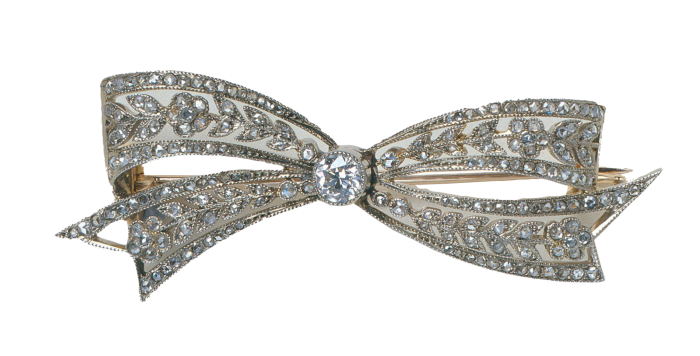Auction houses aim to capitalise on Fabergé ‘buzz’

Roula Khalaf, Editor of the FT, selects her favourite stories in this weekly newsletter.
When Kathleen Wrohan bought a diamond Fabergé tiara for £1,400 on 14 December 1909, she unwittingly set a record. The piece purchased by the mistress of British newspaper baron Lord Northcliffe was the most expensive ever sold at the London branch of the Russian goldsmith and jeweller.
This little-known outpost, frequented by Edwardian high society, is now the focus of a new exhibition opening at the V&A museum on November 20. And auction houses hope the focus on a company best known for its lavish Easter eggs will have a positive impact on sales of its other work, including jewellery.
“Fabergé is so quintessentially Russian and it’s part of that whole fairytale perception of imperial Russia, the grandeur of St Petersburg, the status of the people that inhabited it, and the jewellery and works of art that were the accoutrements of their life,” says Kieran McCarthy, joint managing director of Wartski, a London firm specialising in Fabergé and antique jewellery. “But what people don’t realise is that it was actually an Anglo-Russian love affair.”
Peter Carl Fabergé, son of founder Gustav Fabergé, opened an office in London — his only branch outside Russia — in 1903 after his success at the Exposition Universelle in Paris, three years earlier. He had a discreet presence until moving to New Bond Street in 1911 and the building that today houses French fashion house Chanel.

According to McCarthy, curator of the exhibition ‘Fabergé in London: Romance to Revolution’, Fabergé chose the UK capital because of the close kinship between the Russian imperial and British royal families — the latter became the branch’s primary customers — and the access the city gave him to both domestic and international clients.
The branch was “a venue for exquisite and extravagant jewellery”, says McCarthy. Surviving ledgers show that jewels were the most expensive sales. The exhibition includes a Russian amethyst pendant bought in 1913 by Princess Victoria, daughter of King Edward VII, and a diamond bow brooch purchased by Baron Alphonse Mayer von Rothschild in 1912.


There were historical elements to Fabergé’s jewellery, says McCarthy, but it was also “incredibly modern” and had a fineness that differentiated it from other houses. He says this “absolute stripping away of every sort of superfluous detail to leave an idea” is demonstrated by the delicate winter-themed jewels in the exhibition — including a snowflake brooch and ice crystal pendant designed by the young female designer Alma Pihl for the oil magnate Emanuel Nobel.
Tiaras were the most elaborate pieces. McCarthy says Fabergé’s success as a goldsmith has overshadowed his jewellery — noting that grand Fabergé jewels do not survive in the numbers they do for Cartier, for example, because they were broken up and sold by the Bolsheviks to fund their Treasures for Tractors industrialisation programme.

The Russian Revolution closed Fabergé in Russia in 1918. The London branch had shut the previous year: shipments from the Russian workshops had ceased because of the first world war, while the conflict prompted a change in mood that meant Fabergé’s pieces had become “unnecessary indulgences”, says McCarthy.
Faberge’s London customers later became clients of Wartski, which acquired confiscated pieces sold by Soviet Russia in the 1920s.
A century on, auction houses are hoping to capitalise on the focus on Fabergé. Christie’s is holding a sale of 86 Fabergé pieces including jewellery in London on November 29. Amassed over a period of nearly 50 years by private collector Harry Woolf, it is expected to fetch £2.15m-£3.15m. Other pieces owned by Woolf will feature in the V&A show.
“People are completely beguiled by the eggs, and rightly so, but there is so much to Fabergé that a lot of people will not know about,” says Sophie Law, specialist in the Russian department at Bonhams. “I think, when people see [in the exhibition] this huge range of pieces that Fabergé made, they will be inspired to look perhaps into collecting, which would be the most wonderful knock-on result because a lot of it is far more affordable than one might think.”
She says Fabergé miniature egg pendants sell at auction with low estimates starting from £3,000, making them “eminently collectible”. Bonhams is offering a varicoloured gold, enamel and carved chalcedony example, which is dated 1903-4 and is a vinaigrette, in London on December 1 with an estimate of £8,000-£10,000. Law hopes the timing coincides with a “buzz for Fabergé”.
Contemporary guilloché enamel fine jewellery egg pendants are also a bestseller for the jeweller now trading as Fabergé. Launched in 2009 after acquiring the global trademarks and associated rights to the Fabergé name from Unilever, the wholly-owned subsidiary of Gemfields has 100 global points of sale, with plans to at least double this — to between 200 and 250 — by 2025.
For McCarthy, anything that came after the end of Carl Fabergé’s business “is not Fabergé”. But those seeking to collect the original jewels face a challenge: he says the passion for Fabergé’s jewellery is “incredibly strong”; and the supply is “incredibly small”.
Fabergé in London: Romance to Revolution opens at the V&A museum in on November 20
Comments